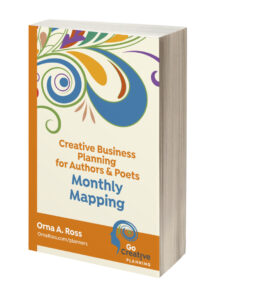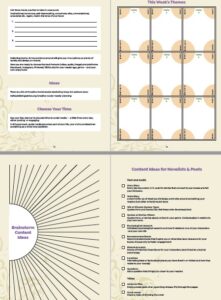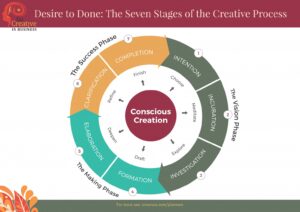Are you ready for 2023? Alliance of Independent Authors founder and director Orna Ross runs runs a small-group Publishing for Profit Program for self-publishing authors and poets and this week we are running a blog series introduction to the method. Today is Part Two: the creative planning process for authors.
This creative planning for profit method and membership is designed to boost your productivity (making), streamline your processes (managing) and sell more of your books (marketeering).
In Part One, you explored the unique value you bring to your readers, what it is about your books that makes them valuable to others? In this post, we take an overview of the creative planning process that will take you from where you are now to where you want to be.
Like Part One, this post is full of exercises. Planning isn't something you read about, it's something you do. Take a pen and paper and go somewhere you won't be disturbed for about 90 minutes.
Creativity is the process of getting from desire to done but because we are human beings, not machines, that process is not always straightforward.
You can apply the process creative planning process for authors at the large scale, to a five-year plan for a writing and publishing business, for example, or to any specific aspect of your work: a book to finish, a promotional launch to arrange, a money goal you want to reach or surpass.
 Creative Planning Process for Authors: 1. Where you are now?
Creative Planning Process for Authors: 1. Where you are now?
Good creative planning always begins with a review, looking at what's currently happening in the arena in which you want change. There are many ways to evaluate the performance of your author-publishing business. e.g. sales figures, reader reviews, traffic to your website, social media engagement.
There are four measures that are most relevant for you, as an author-publisher who wants to create a profitable business from selling books.
• productivity: Your output. Expressed as words completed (writing productivity) and books published (publishing productivity).
• profits: Your financial rewards. Expressed as money paid across to yourself after all your publishing expenses are paid (personal bank deposit).
• purpose: Your influence and impact. Expressed as platform, reach and engagement with your mission and what is most meaningful for you as a writer (book sales, follower numbers, and engagement ).
• personal satisfaction: Your pleasure in your work. Expressed as a reading from one to ten based on internal self-observation, one being misery and ten creative bliss–your creative happiness quotient (CHQ).
Taking a reading on each of these will give you a measure of where you're at, right now, that you can use to see how you're growing, going forward. The outer measures of productivity and profit (products, sales, account balances) give us desired endpoints to travel towards, while the inner measures of creative purpose and personal satisfaction keep us connected not just to what we’re creating, but to how we’re creating.
To expand on this, and get pointers for the direction you take to expand and growing, three tools are particularly valuable. Assess comparable authors, do a SWOT evaluation, and look closely at what's flowing and what's failing in different aspects of your business, right now, wearing the three hats of maker, manager and marketeer, to see clearly where those weaknesses and strengths lie.
1. Comparable Authors
Compile a list of comparable authors and think about your own work compared to theirs–not in any hierarchical way, but at the level of offering.
- What do these authors offer the engaged reader?
- How does that compare to your offering?
- What can you learn from their book descriptions, covers, and reviews?
- What’s not out there that you'd like to write and publish? Think ahead to how you will market the book. What will make it special, stand out from others in your genre? Look back at the work you did on values in Part One.
2. SWOT Evaluation
Considering the strengths and weaknesses, opportunities and threats your author-publishing business is facing is another proven way to evaluate where you are right now.
A SWOT analysis is a business tool used to evaluate your strengths, weaknesses, opportunities, and threats, a way to assess the internal and external factors that can impact your success.
- S = Strengths: The strengths of a business or individual refer to the things they do well or the resources they have at their disposal. These might include skilled employees, a strong brand, or a unique product.
- W = Weaknesses: areas where you are lacking or at a disadvantage. e.g. a lack of financial resources, limited experience, weak marketing.
- O= Opportunities: potential for growth or success. These might include new market trends, changes in the industry, or collaberations with other authors.
- T = Threats: external factors that could negatively impact your success e.g. changes in laws or regulations, reading trends, economic downturns.
By examining these four areas, you can identify their strengths and weaknesses, and come up with strategies to take advantage of opportunities and mitigate threats.
3. What's Flowing and What's Failing?
To establish what's flowing and what's failing in your business, don your three hats in quick succession, and ask yourself questions.
Wearing your maker hat (writing and book production):
- Do you have a production plan?
- What have you automated?
- Do you have the assistance you need? What have you outsourced?
- Are you distributing on as many platforms as possible?
- What else?
Wearing your marketeer hat (marketing, promotion and sales)
- Do you have a marketing plan? Does it suit your writing? Your personality? Your publishing framework?
- When is your next book launch? Do you have a launch plan?
- How do you promote your books–ads, influencers, social media, other?
- What else?
Wearing your Manager hat (processes and profit)
- What is your business model–exclusive, wide, rights, publisher, creator?
- What book(s) or other products generate most revenue for you?
- Do you pay yourself first?
- Is your banking and accounting organized and clear?
- What are your average monthly costs? What ROI are you aiming for?
- Have you set a budget for each book? Have you
- automated and streamlined where possible?
- Do you have a money day each month?
- How is your relationship with money?
- What else?
2. Where are you going?
What are your creative intentions, in terms of your personal passion, mission and values, and the kind of profit you’d like to make and influence you’d like to have as an author-publisher? what books and other products will you create, how much money do you want to feed your bank accounts?
Read this post to see how creative intentions differ from goals.
Creative Intentions:
- Select High Value Priorities
- Emphasise the Positive
- Acknowledge the Unconscious
- Harness the Imagination
- Accept You as You Are
- Stay Flexible
- Relish The Process
- Think Long Term
3. How are you going to get there?
There are two aspects to this. The first is understanding and applying the creative process itself and the second is setting up the creative conditions you need to flourish.
3a. Getting There: The Creative Process
Most people who start to write a book never get to type “The End”. Most publishers, indeed most businesses, fail to make enough profit to survive. Most new year’s resolutions are broken within a week. There are individual reasons for these failures to finish, but what those who berate themselves for a lack of willpower don’t understand is that there is also a single, shared reason. Somewhere along the line, the creative process broke down.
Whenever we want to consciously create something we go through a seven-stage process between intention and completion. This process always goes through the same loop, whatever we're aiming to make. A paragraph of fine writing, a ebook or audiobook, a thriving business—all begin with an intention, a sense of the outcome we want, and then proceed through seven stages to deliver that outcome.
Or not.
I’ve written out the stages in a row below to help us to understand them–but the creative process is not linear. Each stage melds into and interweaves around the other, in an interactive waltz.
The creative process is employed when we are creating anything, whether we are conscious of that or not.When we’re making something that comes easy to us—a short story, breakfast, $5 profit—we don’t notice the stages. We go from intention to completion without even thinking about it, especially if it’s something we’ve made often before.
When something’s new to us and when it’s a stretch—a long novel, a 50-seater banquet, a successful business—it helps to be be more aware of the process. That awareness means we follow the right steps at the right time — and we enjoy the dance.
The creative process is both universal and unique. Give a hundred writers a prompt and you'll get a hundred completely different stories or poems. Give a hundred indie authors a blank business plan and you'll get a hundred completely different publishing businesses.
The seven stages are intention, incubation, investigation, formation, elaboration, clarification and completion. They can be organised under three phases: vision, making, and revision, as follows:
The Seven Stages of the Creative Process
The Vision Phase
1. Intention —> Survey, choose, commit
2. Incubation —> Meditate, f-r-e-e-write, cogitate
3. Investigation —> Research, explore, experiment
The Making Phase
4. Formation —> Plan, draft, design
5. Elaboration —> Deepen, develop, expand
The Revision Phase
6. Clarification —> Refine, correct, contract
7. Completion —> Finalise, finish, release
Each stage of the process call for different skills and approaches. Without awareness of what phase and stage we are at in our projects, we can easily derail ourselves by bringing in thoughts and behaviors that belong to another stage.
A common example in writing is to start self-editing (stage 6) before early ideas and insights have been given time to develop (stage 2) or solidify (stage 4).
A common example in publishing is pressing the production button (stage 4) on a manuscript that needs more developmental edit (stage 3). Or rushing to market (stage 7) a book without sufficient preparation (stages 2,3) and positioning (4,5)
All of these issues are fixable afterwards. One of the great things about self-publishing is the ability to go back and do better but we have an easier and far more enjoyable time when we recognise that the creative process is infallible and takes as long as it takes. It all happens faster when we stop pushing.
When we allow the process to lead, when we trust it and follow its natural flow, it finds its own way. The creative qualities of insight and inspiration, perception and enlightenment, emerge. We stop seeing blocks and obstacles as insurmountable. We imagine more expansive possibilities. We integrate different aspects of ourselves. We align with flow.
As creatives, we can use our knowledge of the process to accurately pinpoint where we are meeting creative resistance and block. We can clearly see how the process is ignited and sustained through the seven stages of the process by directed passion.
The Creative Process: Writing
The Vision Phase
1. Intention —> Decide on your idea
2. Incubation —> Invite in insights and intuitions. Brainstorm your idea, meditate and f-r-e-e-write to deepen your thoughts.
3. Investigation —> Whatever helps to gain a deeper understanding of the subject .e.g online research, books and journals, interviewing experts or individuals, visiting museums and libraries, observing and experiencing events or situations.
The Making Phase
4. Formation —> First Draft
5. Elaboration —> Deepen and develop the draft. Add details or expand information. Refine language, develop characters or setting, add sub-plots, paragraphs, even chapter as necessary to fill all gaps and make sure the reader understands what you need them to understand.
The Revision Phase
6. Clarification —> The self-editing phase. Everything up to now has been expansion. Now it’s time to refine, correct, contract, delete, eliminate.
7. Completion —> Finish the manuscript and prepare to release it to beta readers or editors.
The Creative Process: Publishing
The Vision Phase
1. Intention —> To become a good publisher of the kinds of books you will release.
2. Incubation —> Do some deep thinking and f-r-e-e-writing about the kind of publisher you want to be and how you can reach more readers and sell more books (which is what all good publishers do)
3. Investigation —> Research how other similar publishers do what you want to do and sourcing the tools and team you’ll need.
The Making Phase
4. Formation —> Deciding on a framework and setting up your publishing and business structure. Drawing up your publishing schedule and putting out your first books.
5. Elaboration —> Developing and expanding your business, based on the learnings. Trying new things.
The Revision Phase
6. Clarification —> Understanding what books and publishing approaches do best for you and letting the others go. Consolidating systems to support regular production. Refining your team and tools.
7. Completion —> Establishment of a mature publishing business that generates a profit and supports your writing without consuming too much time, attention or resources.
3b. Getting There: Creative Conditions
The internet is full of writers counting words and yes, getting our writing done is vital but it’s only one strand of success for an indie author, who is a publisher as well as a writer. We need to organize tools, tech and a publishing team (editors, designers, and formatters, assistants) into a cohesive unit that enables us to write and publish well.
This means harnessing our own time, resources, and creative conditions optimally. It means recognizing the three hats we must wear to get our work done, and know which one we are wearing at a particular time, maker (writing words and producing books), manager (improving processes and profits) or marketeer (promoting books and other products and projects)
We need to set in place the correct creative conditions, the right product ecosystem of books and other products, a banking and financial account system that supports your creative business in the way you need support, as well as the tools, tech and team.
The two most important conditions are time and space.

Blank bookcover with clipping path
Time
All of these creative stages take time, and we also need to take time for creative rest and play, to take breaks and recharge.
Establishing a regular schedule can help us to allocate our time more effectively. Set aside specific blocks of focussed time for deep work like writing and research, and other tasks. Take creative breaks to rest and recharge and seek out the support you need. Asking for help or delegating tasks to others frees up time to do the creative tasks that only you can do.
Space
Though we can do our work anywhere, having a dedicated, comfortable area to work in, where you can focus on your writing without interruptions, is a boon to most writers. Additionally, having access to resources such as a computer, books, and other writing materials can help to reduce distractions and increase productivity.
Identify and eliminate distractions to stay focused and make the most of your time. Turning off notifications on devices, set boundaries with others, escape to your ideal creative space.
As you grow and develop as an indie author, your grow into an understanding of your own creative process and what you need to nurture it. These can change over time.
CONSIDER THIS: What are the creative conditions you need right now to achieve what you want to achieve–in writing, in publishing, in business?
Don't get hung up on having the perfect conditions. That can be a sophisticated form of resistance.
The Creative Planning Process for Authors: The Planners

social media planners
Like most planning systems, the Go Creative! program begins with framing creative intentions and goals over the long term, typically a year, or maybe five years or even ten ahead, then breaks these down into goals and intentions for the next year, by dividing it into four quarters.
Each quarter is then divided into three months, each month into four weeks, each week into how ever many working days you want to incorporate, and each working day into hours—until you are clear about the tasks you have to do in the time available right here, right now.
In short, this method structures your ideas and harnesses creative flow, giving them the space they need to be highly productive: making great books, reaching more readers, and steadily increasing your influence and impact and income over time.
The program is ongoing, and you can step into any plan at any point.
Trying creative business planning means doing more than reading about it and half-heartedly trying some of it, piecemeal. Unless you actively implement it, you won’t experience its power.
I’ve come to believe that proper planning is necessary for indie authors to reach their publishing potential—but I do know that planning may not work for every brain and personality. All good. If you need permission not to plan, you have it! Having said that, if you’re not seeing the success you want, do try this more formal planning approach for a quarter (three months) and see does it make a difference.
4. How will you know when you’ve arrived?
You’ll be measuring, remember.
• productivity: Your output. Expressed as words completed (writing productivity) and books published (publishing productivity).
• profits: Your financial rewards. Expressed as money paid across to yourself after all your publishing expenses are paid (personal bank deposit).
• purpose: Your influence and impact. Expressed as platform, reach and engagement with your mission and what is most meaningful for you as a writer (book sales, follower numbers, and engagement ).
• personal satisfaction: Your pleasure in your work. Expressed as a reading from one to ten based on internal self-observation, one being misery and ten creative bliss–your creative happiness quotient (CHQ).
 Find out more about this and how it all hangs together in my book, Creative Self-Publishing.
Find out more about this and how it all hangs together in my book, Creative Self-Publishing.
If you would like more support, including regular workshops and a weekly accountability group, find out more about my Creative Planning for Profit Program here.





